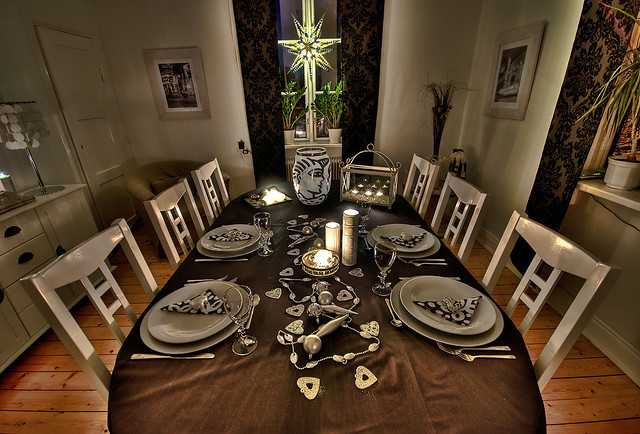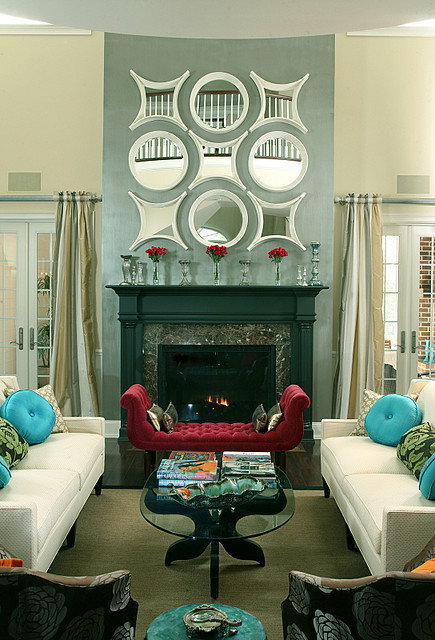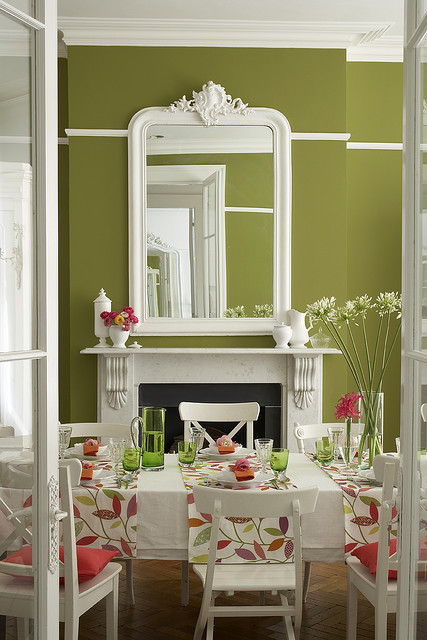Chatty Cathys talk all the time. They are the life of the party even when there's no party. Quiet Quentins hardly ever speak, even when people ask them questions. Every gathering you host this holiday season will include some Cathys and Quentins, as well as a slew of regular Janets and Joes. You'd like the Cathys, Quentins, Janets, and Joes all to laugh and talk and have a great time at your party. Can where you seat people at dinner and put the furniture encourage conversation? Yes.
Figuring out where everyone should sit during dinner can be torture. But you have options. First, you need to decide if you will (or can) go big or small -- one large table or several small ones?
The advantage of smaller tables, seating say six or eight people, is that everyone sitting at a smaller table will be in eye contact with everyone else. We're social animals and eye contact leads to conversation. Also, silence makes us tense and if silence descends on one of those small tables one of the people sitting there will break it -- there'll be more silence breakers in the room overall if there are more tables. Once people become involved in a conversation they are likely to continue to talk.

Flickr photo by borevagen
If you opt to sit everyone at one bigger, rectangular table, you can still keep conversation rolling. Open up the "heads" of the tables -- don't seat anyone there. The people sitting at the heads or short ends of a table become the leaders of dinner conversation and dinner guests get thinking, whether they realize it or not, about any sort of hierarchy that may exist among them -- that stifles discussion.
Arrange your Chatty Cathys in a "W" across the long sides of the table -- better yet make it a nice wide "W" with a set of people directly across from each other between those Chatty Cathys who are seated on that cross-table diagonal. When those Cathys start to do what comes naturally to them and talk to each other, they'll be looking at each other at angles that make it more likely that they'll catch the eyes of other people in the process, which will get the non-Cathys involved as well. Sit your most effervescent guest halfway down one side of the table. That'll get people on both ends talking.
The time at the dinner table may be the "main event" at your party, but people will not march from your front door directly to their seats at the table or from their seats back out the door. Or, you may not serve a seated dinner at all. What then?

Flickr photo by Posh Living, LLC
People are most comfortable and relaxed talking to each other if they are sitting at right angles to each other. So give them plenty of opportunities to do just that. When people are comfortable, they talk to each other. The right angle thing can be tricky to visualize so think of it like this: imagine that there is a line drawn across the front of the seat of the people talking -- those lines should intersect at 90 degrees.
Make sure people are sitting at a comfortable distance from each other -- and what's comfortable varies from country to country. Let's focus on the distances in the U.S. People who know each other pretty well will talk standing about 3 feet from each other, and it is great if your dining table allows you to place the diners' chairs so that the distance from the middle of the back of one chair to the middle of the back of the next chair is about 30" to 36". Some of the chairs away from the dinner table should be this far apart, and some should have a slightly larger space between them -- those are for people who are not as well acquainted.

Flickr photo by little.greene
A couple of other points: Make sure that at least some of your chairs are light enough so that when they're schmoozing people can move them into configurations that feel right to them. People feel really comfortable sitting in a chair when something is behind their back - like a wall (tall or short) or a plant. Make sure some of your chairs are "backed up" in this way. If Quiet Quentins feel comfortable, they're more likely to join in a conversation. Finally seeing ourselves in mirrors makes us more likely to follow social norms. For most, the social norm at parties is to mingle, so mirrors can add life to the party.
Finally, give people something to talk about. There's apt to be a lively conversation in chairs grouped near a blazing fire, for example. Anyone who comes by can comment on the fire, an easy way to get involved in a conversation. Remember: the physical environment is a tool you can use to make all sorts of situations happen -- including a conversation packed party.